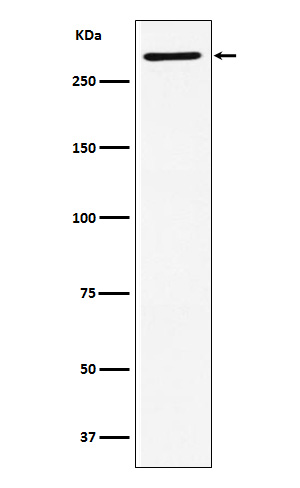EDD Rabbit mAb
- 产品详情
- 实验流程
Application
| WB |
|---|---|
| Primary Accession | O95071 |
| Reactivity | Human, Mouse |
| Host | Rabbit |
| Clonality | Monoclonal Antibody |
| Isotype | IgG |
| Conjugate | Unconjugated |
| Immunogen | A synthesized peptide derived from human EDD |
| Purification | Affinity Purified |
| Calculated MW | 309352 Da |
| Gene ID | 51366 |
|---|---|
| Other Names | UBR5 |
| Dilution | WB~~1/500-1/1000 |
| Format | Liquid in 10mM PBS, pH 7.4, 150mM sodium chloride, 0.05% BSA, 0.02% sodium azide and 50% glycerol. |
| Storage | Store at 4°C short term. Aliquot and store at -20°C long term. Avoid freeze/thaw cycles. |
| Name | UBR5 |
|---|---|
| Function | E3 ubiquitin-protein ligase involved in different protein quality control pathways in the cytoplasm and nucleus (PubMed:29033132, PubMed:33208877, PubMed:37478846, PubMed:37478862). Mainly acts as a ubiquitin chain elongator that extends pre-ubiquitinated substrates (PubMed:29033132, PubMed:37409633). Component of the N-end rule pathway: ubiquitinates proteins bearing specific N-terminal residues that are destabilizing according to the N-end rule, leading to their degradation (By similarity). Recognizes type-1 N-degrons, containing positively charged amino acids (Arg, Lys and His) (By similarity). Together with UBR4, part of a cytoplasm protein quality control pathway that prevents protein aggregation by catalyzing assembly of heterotypic 'Lys-11'-/'Lys-48'-linked branched ubiquitin chains on aggregated proteins, leading to substrate recognition by the segregase p97/VCP and degradation by the proteasome: UBR5 is probably branching multiple 'Lys-48'-linked chains of substrates initially modified with mixed conjugates by UBR4 (PubMed:29033132). Together with ITCH, catalyzes 'Lys-48'-/'Lys-63'-branched ubiquitination of TXNIP, leading to its degradation: UBR5 mediates branching of 'Lys-48'-linked chains of substrates initially modified with 'Lys-63'-linked conjugates by ITCH (PubMed:29378950). Catalytic component of a nuclear protein quality control pathway that mediates ubiquitination and degradation of unpaired transcription factors (i.e. transcription factors that are not assembled into functional multiprotein complexes): specifically recognizes and binds degrons that are not accessible when transcription regulators are associated with their coactivators (PubMed:37478846, PubMed:37478862). Ubiquitinates various unpaired transcription regulator (MYC, SUPT4H1, SUPT5H, CDC20 and MCRS1), as well as ligand- bound nuclear receptors (ESR1, NR1H3, NR3C1, PGR, RARA, RXRA AND VDR) that are not associated with their nuclear receptor coactivators (NCOAs) (PubMed:33208877, PubMed:37478846, PubMed:37478862). Involved in maturation and/or transcriptional regulation of mRNA by mediating polyubiquitination and activation of CDK9 (PubMed:21127351). Also acts as a regulator of DNA damage response by acting as a suppressor of RNF168, an E3 ubiquitin-protein ligase that promotes accumulation of 'Lys-63'-linked histone H2A and H2AX at DNA damage sites, thereby acting as a guard against excessive spreading of ubiquitinated chromatin at damaged chromosomes (PubMed:22884692). Regulates DNA topoisomerase II binding protein (TopBP1) in the DNA damage response (PubMed:11714696). Ubiquitinates acetylated PCK1 (PubMed:21726808). Acts as a positive regulator of the canonical Wnt signaling pathway by mediating (1) ubiquitination and stabilization of CTNNB1, and (2) 'Lys- 48'-linked ubiquitination and degradation of TLE3 (PubMed:21118991, PubMed:28689657). Promotes disassembly of the mitotic checkpoint complex (MCC) from the APC/C complex by catalyzing ubiquitination of BUB1B, BUB3 and CDC20 (PubMed:35217622). Plays an essential role in extraembryonic development (By similarity). Required for the maintenance of skeletal tissue homeostasis by acting as an inhibitor of hedgehog (HH) signaling (By similarity). |
| Cellular Location | Nucleus. Cytoplasm |
| Tissue Location | Widely expressed. Most abundant in testis and expressed at high levels in brain, pituitary and kidney |
Research Areas
For Research Use Only. Not For Use In Diagnostic Procedures.
Application Protocols
Provided below are standard protocols that you may find useful for product applications.
终于等到您。ABCEPTA(百远生物)抗体产品。
点击下方“我要评价 ”按钮提交您的反馈信息,您的反馈和评价是我们最宝贵的财富之一,
我们将在1-3个工作日内处理您的反馈信息。
如有疑问,联系:0512-88856768 tech-china@abcepta.com.
¥ 1,500.00
Cat# AP78326























 癌症的基本特征包括细胞增殖、血管生成、迁移、凋亡逃避机制和细胞永生等。找到癌症发生过程中这些通路的关键标记物和对应的抗体用于检测至关重要。
癌症的基本特征包括细胞增殖、血管生成、迁移、凋亡逃避机制和细胞永生等。找到癌症发生过程中这些通路的关键标记物和对应的抗体用于检测至关重要。 为您推荐一个泛素化位点预测神器——泛素化分析工具,可以为您的蛋白的泛素化位点作出预测和评分。
为您推荐一个泛素化位点预测神器——泛素化分析工具,可以为您的蛋白的泛素化位点作出预测和评分。 细胞自噬受体图形绘图工具为你的蛋白的细胞受体结合位点作出预测和评分,识别结合到自噬通路中的蛋白是非常重要的,便于让我们理解自噬在正常生理、病理过程中的作用,如发育、细胞分化、神经退化性疾病、压力条件下、感染和癌症。
细胞自噬受体图形绘图工具为你的蛋白的细胞受体结合位点作出预测和评分,识别结合到自噬通路中的蛋白是非常重要的,便于让我们理解自噬在正常生理、病理过程中的作用,如发育、细胞分化、神经退化性疾病、压力条件下、感染和癌症。






